If you’ve planted an apple tree and wondered why it never produced more than a few beautiful blossoms, you’re in good company.
Many of us will head out to the garden centers in springtime, purchase our favorite type of apple tree, and rush home to plant it.
We tend to these new plantings with love and attention, and we even understand that it could take a few years before we see a single fruit.
Three years go by, and nothing. Then four. Then five. And then six. And now we’re wondering what we did wrong.
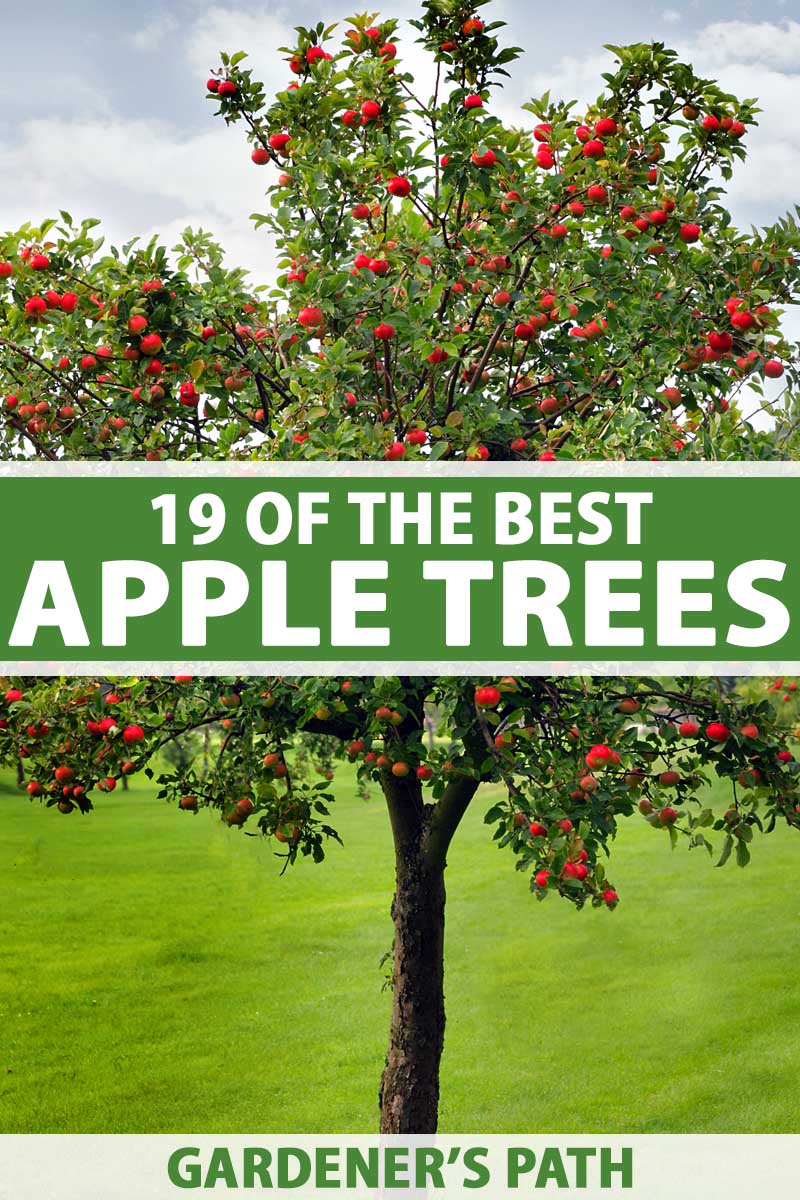
We link to vendors to help you find relevant products. If you buy from one of our links, we may earn a commission.
The solution is at once complex and simple, but don’t worry. Keep on reading, and by the end you’ll be well-prepared to choose and plant that apple tree, and then harvest its fruit.
Here’s an overview of what’s ahead:
The Best Apple Varieties
Read on for the best apple varieties for your growing zone, information on how they get along, and more.
The Important Bits
I’ve broken up the main highlights on how to grow an abundant harvest successfully below, to give you a better idea of what each key element of information actually means.
As you’re reading, you’ll get a primer on what to expect when growing apple trees; at times, it may seem a bit overwhelming.
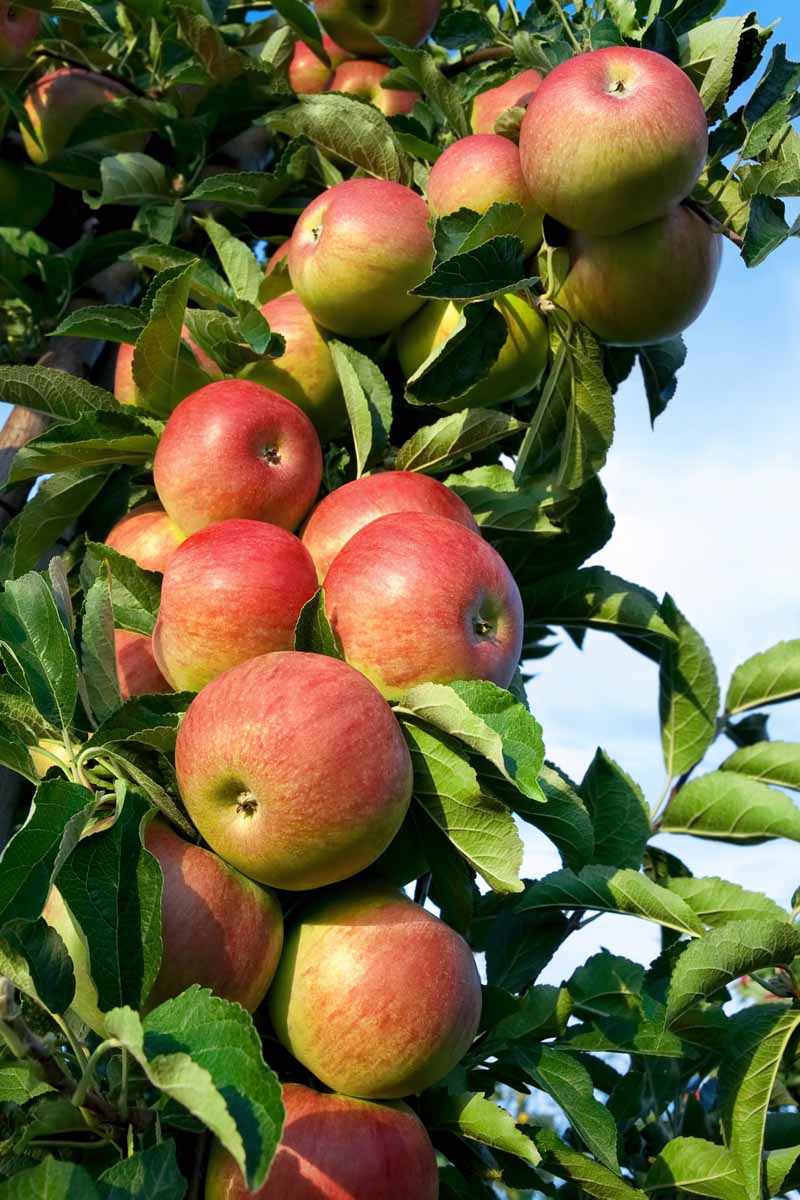
Stick to it, and I’ll summarize at the end (see the boxed out section below)!
Growing Zones
Apple trees tend to thrive in areas with nice, cold winters. Most won’t grow anywhere warmer than zone 8, but there are a few exceptions, as you’ll see below.
Chill Hours
Cool periods are so important to apple trees that they actually need hundreds of “chill hours” every year to break dormancy, and regulate growth.
You can’t cheat this system; these trees need a specific range of cool weather hours (in the range of 32-45°F) to survive and prosper.
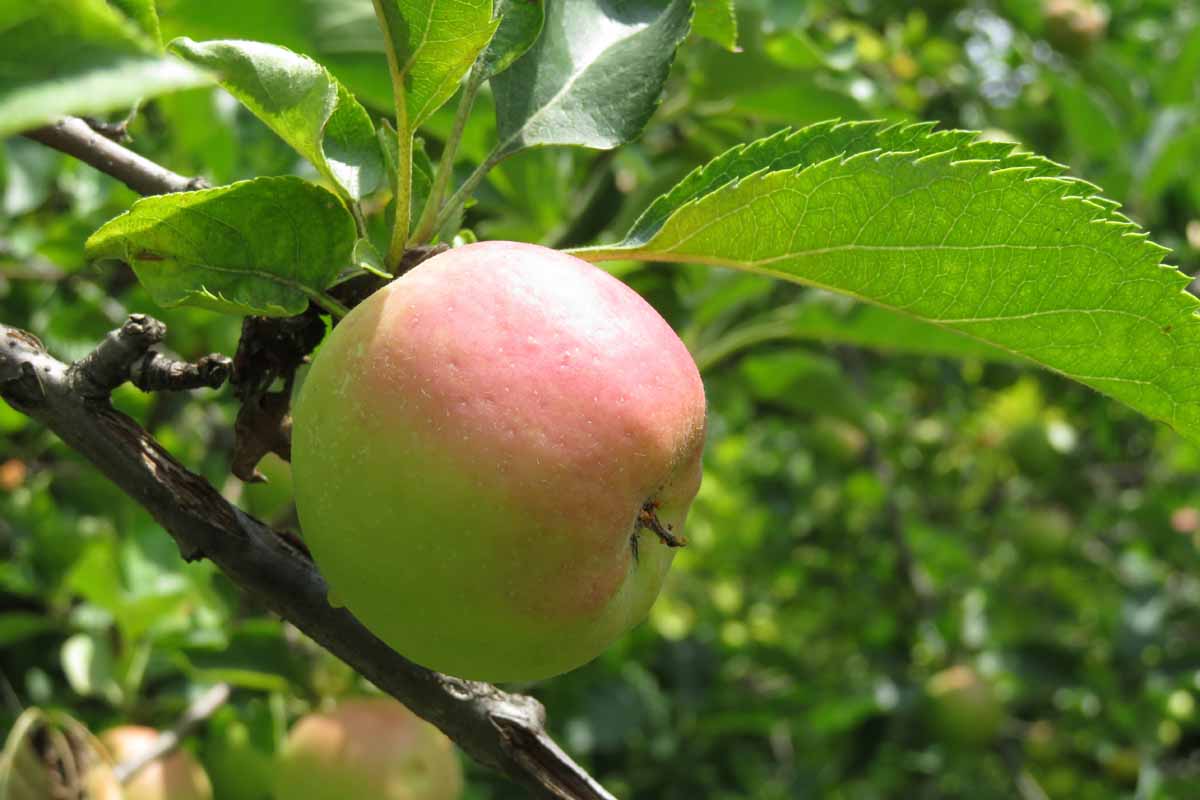
Determining your exact amount of chill hours can be tricky business, so a good estimate is usually the way to go. You could either calculate this number yourself by examining your average winter weather (typically from September to April) and finding a rough estimate of how many days fit this temperature range.
Another option is to use this fancy calculator and enter your zip code. The calculator can take a few minutes to get you the information you need, so a bit of patience is required.
Multiple methods are used to calculate chill hours, each with its own benefits and drawbacks. Use these numbers as estimates for your own garden.
Flowering Groups
Apple trees bloom at different periods of the year, and because most require cross-pollination between at least two types of apple, you’ll need to select trees that bloom during the same period.
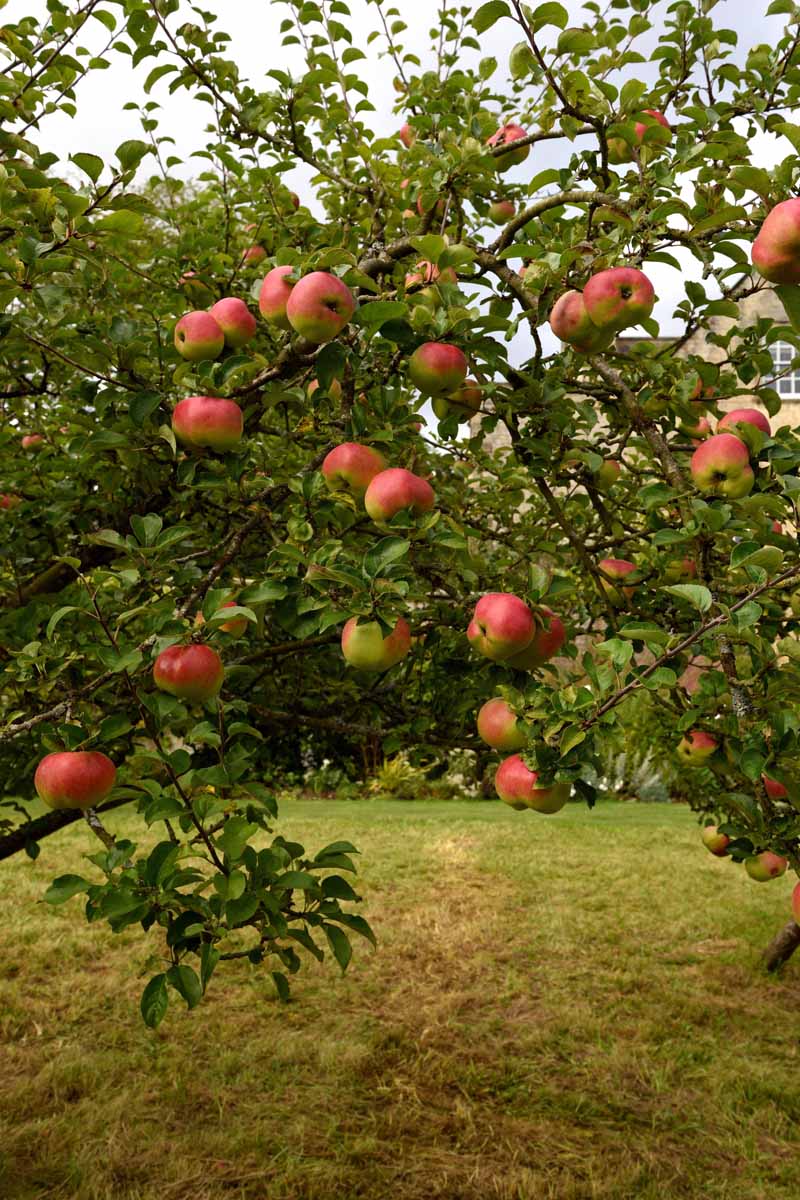
Unsurprisingly, these flowering periods are broken into groups:
- Group 1: Pollinated by Groups 1, 2
- Group 2: Pollinated by Groups 1, 2, 3
- Group 3: Pollinated by Groups 2, 3, 4
- Group 4: Pollinated by Groups 3, 4, 5
- Group 5: Pollinated by Groups 4, 5, 6
- Group 6: Pollinated by Groups 5, 6, 7
- Group 7: Pollinated by Group 6
Some apples will self-pollinate, meaning they don’t strictly need another apple tree to produce fruit (thought this will generally help you to get a bigger harvest, in all cases).
Many trees need a different cultivar in close proximity to pollinate fruit through a process called “cross pollination”.
And don’t forget apples that are “triploid,” a biological term that translates to, “needs two separate pollinators to produce fruit.” These trees are best left to those with enough room to grow at least a few trees on their property.
Lastly, crabapple trees can pollinate regular apples, but only if they are in bloom during the same period.
Height
Pretty simple here! This is an average expected height for your trees to reach.
Most will have a spread, or width, that is similar to their height. Make sure you’ve got room for the trees to grow and spread out!
Recommended Uses
Each of these 19 varieties includes some recommendations or special notes. Maybe it’s a good use for the fruit, or growing considerations. Each one is different, and you’re gonna have to check out each tree to find what they are.
I’m Feeling a Bit Lost
Don’t fret! All of this information boils down to the following key points:
- You’re going to have to plant more than one tree if you want it to produce fruit (or plant near a neighbor’s tree).
- Make sure the tree you’re planting can grow in your USDA climate zone.
- Your tree needs to be planted with others that flower at identical or overlapping times.
- Your trees need to planted within 50 feet of one another to cross-pollinate.
- Different cultivars offer different uses, such as eating out of hand, cooking and baking, or making cider.
Flowering Group 1
1. Early Harvest
Talk about an ‘Early Harvest!’ These apples are firm and crisp, and produce fruit very early.
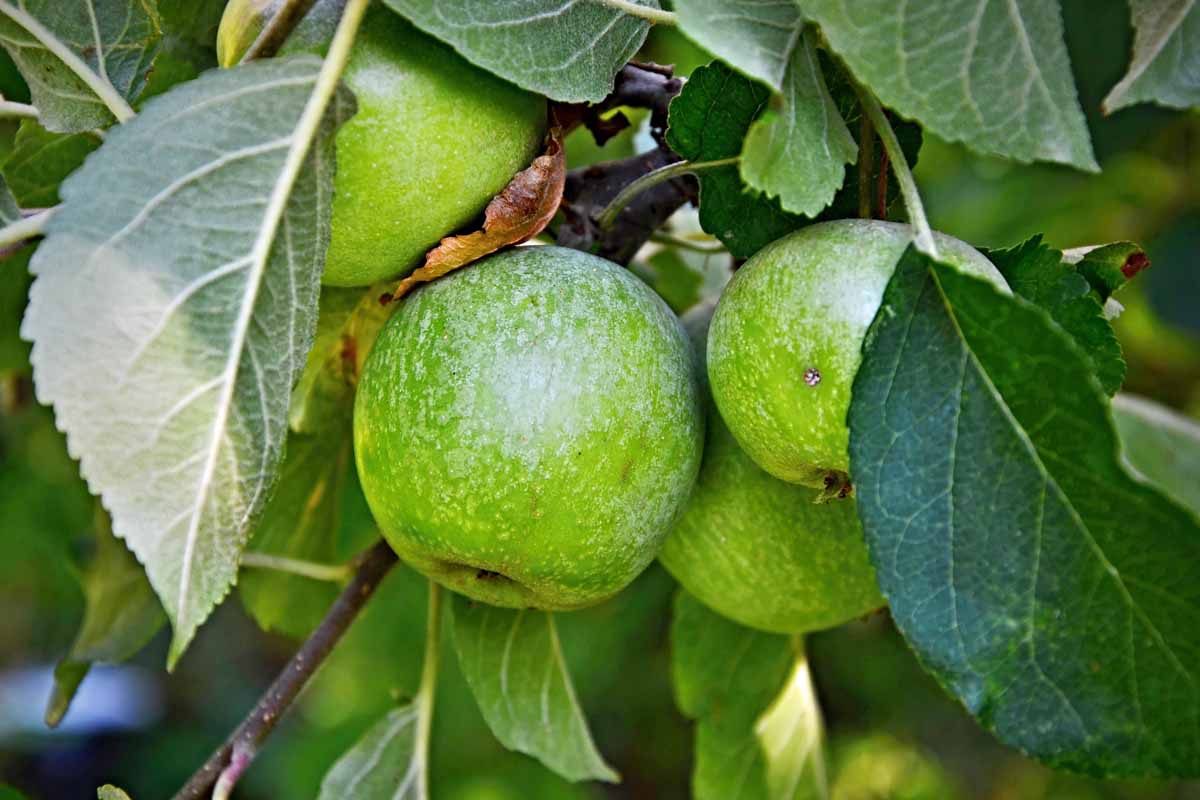
The fruit lasts for weeks in the refrigerator, but like most apples, they taste best when fresh.
‘Early Harvest’ also does well when pollinated with white-flowering crabapples.
- Growing Zones: 3 to 8
- Chill Hours: 800 to 1000
- Pollinates with Flowering Groups: 1, 2
- Height: 20 to 25 feet (dwarf varieties available)
Recommended Uses and Special Notes: When picked young the fruit is excellent for baking. This tree blooms earlier than many other apple cultivars, so consider adding some white-flowering crabapples to your landscape to aid in pollination.
2. Gravenstein
If you like your apples tart (and I sure do), this might be the one you’ve been waiting to pucker up with.
A native to Denmark, the ‘Gravenstein’ is an excellent apple for making into sauces and cider. The fruit tends to ripen unevenly, so frequent picking is recommended.
- Growing Zones: 2 to 9
- Chill Hours: 700
- Pollinates with Flowering Groups: 1, 2
- Height: 15 to 20 feet
Recommended Uses and Special Notes: Triploid! Great for cooking and is hardy to cold weather. Blooms earlier than most.
This cultivar is available from Nature Hills Nursery.
Flowering Group 2
3. Lodi
Oh, lordy, I love a ‘Lodi’ apple. I’ve admittedly never had one of these unless it was from an orchard, but they’re pretty darn good to snack into.
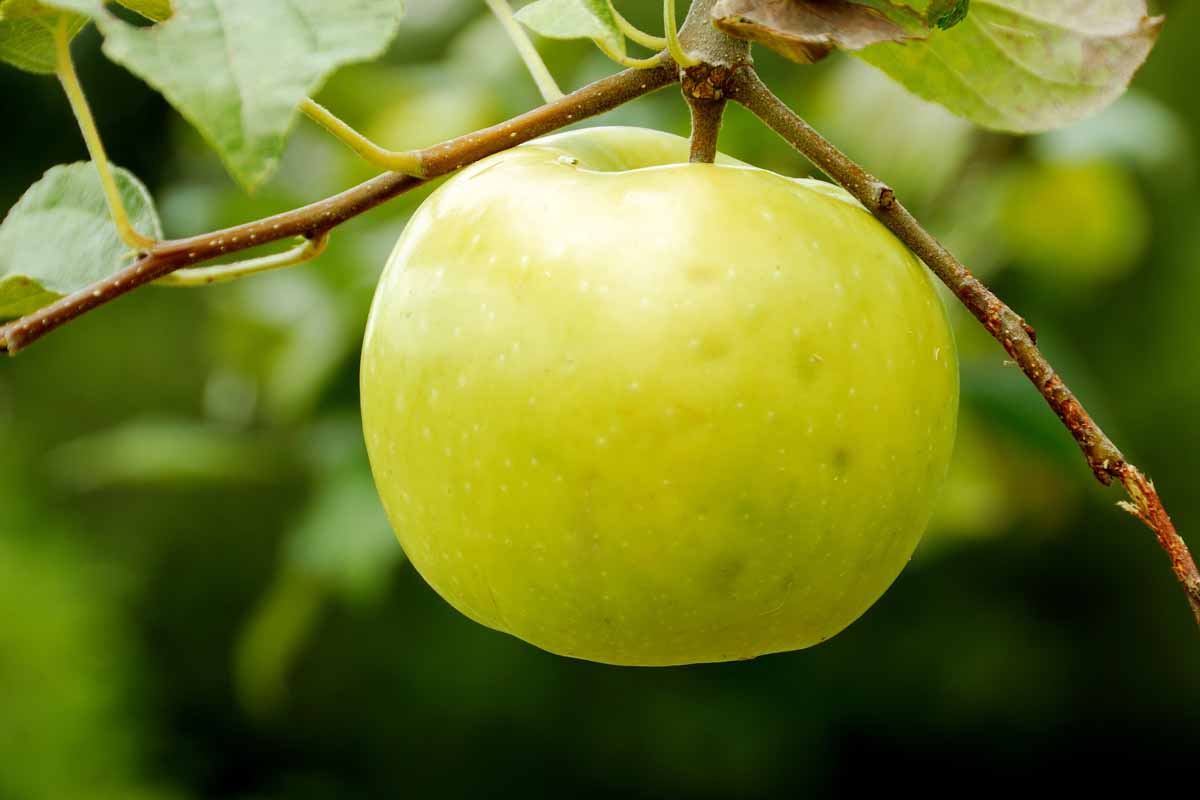
They tend to produce their fruit earlier than many other cultivars, even in Flowering Group 2, so that’s a plus for when you want to start chowing down on homegrown fruit earlier than the fall.
- Growing Zones: 3 to 8
- Chill Hours: 800 to 1000
- Pollinates with Flowering Groups: 1, 2, 3
- Height: 10 to 25 feet
Recommended Uses and Special Notes: Triploid! Excellent for applesauce and early season pies. The fruit freezes better than it survives being refrigerated. Can handle a wider array of soils than other types.
4. McIntosh
I grew up on a dying orchard dominated by ‘McIntosh’ trees, so these are my favorites.
Juicy, tart, and with just the right amount of crunch, the ‘McIntosh’ is perfect for snacking straight from the tree. Or, you could use them to make a pie like my aunts used to do.
They are also beautiful as an ornamental and… you know what? If you can grow a ‘McIntosh,’ grow it! You won’t regret planting this hardy tree with its tasty fruit!
- Growing Zones: 4 to 7
- Chill Hours: 900
- Pollinates with Flowering Groups: 1, 2, 3
- Height: 15 to 20 feet
Recommended Uses and Special Notes: Cold hardy, provides a bountiful and early harvest each year. Pollinators love a McIntosh.
Four to five foot ‘McIntosh’ trees in #3 Containers are available from Nature Hills Nursery.
Flowering Group 3
5. Arkansas Black
If there was a contest for “Coolest Apple Name” it would surely be awarded to the Arkansas Black. Fortunately, the tree is also a hardy and vigorous grower.
The almost-black skin and golden flesh is perfect for cooking, but the tough fruit can be a bit much to easily snack on.
- Growing Zones: 4 to 8
- Chill Hours: 800 to 900
- Pollinates with Flowering Groups: 2, 3, 4
- Height: 12 to 16 feet
Recommended Uses and Special Notes: Triploid! Fruit harvest is large but late in the season. Stores well for extended periods. Great for use in wintertime pancakes.
‘Arkansas Black’ trees are available from Fast Growing Trees.
6. Fuji
A Japanese cultivar bred from American stock, the ‘Fuji’ is always a favorite for fresh eating.
The fruit tastes delicious when used for juicing and cider.
- Growing Zones: 6 to 9
- Chill Hours: 200 to 400
- Pollinates with Flowering Groups: 2, 3, 4
- Height: 10 to 15 feet
Recommended Uses and Special Notes: Does not tolerate drought. Best harvested in early September. Can be stored for up to six months if refrigerated.
Four to five foot ‘Fuji’ trees are available from Nature Hill Nursery.
7. Granny Smith
My number two favorite apple, the ‘Granny Smith’ is a tree with strong limbs and an equally strong flavor.
The fruit is best harvested in October, but because this tree thrives in warmer climates than most cultivars, it makes picking a pleasant experience.
- Growing Zones: 6 to 9
- Chill Hours: 400
- Pollinates with Flowering Groups: 2, 3, 4
- Height: 18 to 20 feet
Recommended Uses and Special Notes: Self-fertile! Great for raw snacking and in baked treats like scones (find the recipe for these and other delicious uses for your harvest on our sister site, Foodal.) Responds very well to regular, careful pruning.
Four to five foot ‘Granny Smith’ trees are available from Nature Hills Nursery.
8. Jonagold
A name that isn’t easy to forget, the ‘Jonagold’ offers a balanced flavor and lovely appearance. The attractive fruit is delicious when eaten raw, and those lovely white flowers are easy to appreciate.
- Growing Zones: 5 to 8
- Chill Hours: 700 to 800
- Pollinates with Flowering Groups: 2, 3, 4
- Height: 12 to 15 feet
Recommended Uses and Special Notes: Triploid! Offers a balanced flavor but needs a balanced growing area as well, with soils that are well-drained, slightly acidic, and of average fertility. Susceptible to root rot in poorly drained areas.
‘Jonagold’ is available from Fast Growing Trees.
9. Macoun
With a fun-to-say name, the ‘Macoun’ is another cultivar that rivals the tastiness of the McIntosh, with fruit that is very sweet.
It can be a little more picky than other cultivars in terms of ideal growing conditions, and prefers especially deep and well-draining soil. But the fruit it provides makes up for its pickiness.
- Growing Zones: 4 to 7
- Chill Hours: 600
- Pollinates with Flowering Groups: 2, 3, 4
- Height: 15 to 20 feet
Recommended Uses and Special Notes: Perfect for fresh eating and for purees and sauces. This type does not do well in storage and should be utilized when fresh. The growing habit is upright and requires diligent, aggressive pruning.
‘Macoun’ apple trees are available from Nature Hills Nursery.
10. Pink Lady
With a name like ‘Pink Lady,’ you can be sure that this apple is a looker. It’s a classic in the grocery store and a great mid-season variety to enjoy straight from the tree.
The trees themselves are quite lovely, and the flavor of the fruit packs a subtle tart punch.
Hold off on eating one of these after you pick it for about a month to experience the flavor at its peak.
- Growing Zones: 6 to 9
- Chill Hours: 200 to 400
- Pollinates with Flowering Groups: 2, 3, 4
- Height: 12 to 20 feet
Recommended Uses and Special Notes: Self-fruitful and a popular choice for regions of the American Southwest that are otherwise devoid of apple species.
‘Pink Lady’ trees are available from Nature Hills Nursery.
11. Red Jonathan
An old-timey tree, the ‘Red Jonathan’ possesses a uniquely sharp taste.
It is excellent for long-term storage with medium-sized apples that are perfect for snacking, and is quite the looker while in bloom.
- Growing Zones: 4 to 8
- Chill Hours: 700 to 800
- Pollinates with Flowering Groups: 2, 3, 4
- Height: 15 to 20 feet
‘Red Jonathan’ trees are available from Perfect Plants Nursery.
12. Wealthy
Quite the looker, the ‘Wealthy’ possesses stunning blooms and has a flavor reminiscent of strawberries.
It is resistant to most apple illnesses, and best of all, the fruit drops on maturity. Talk about easy!
- Growing Zones: 4 to 7
- Chill Hours: 1000
- Pollinates With Flowering Groups: 2, 3, 4
- Height: 12 to 15 feet
Recommended Uses and Special Notes: Great for any culinary purpose. Long bloom period and very juicy fruit.
‘Wealthy’ trees are available from Nature Hills.
Flowering Group 4
13. Empire
The ‘Empire’ is not my favorite variety – but it may be yours!
It’s hard to find a better looking fruit out there, and the modest height of this cultivar makes it an ideal solution for smaller properties.
Some folks claim that the ‘Empire’ outdoes the McIntosh in sheer delectability (but I just can’t agree with that)!
- Growing Zones: 4 to 9
- Chill Hours: 800
- Pollinates with Flowering Groups: 3, 4, 5
- Height: About 15 feet
Recommended Uses and Special Notes: To avoid growing a hundred tiny apples, you’ll want to regularly thin your ‘Empire’ crop to maximize the size of your fruit.
‘Empire’ trees are available from Nature Hills.
14. Gala
Originating from New Zealand (the land down under the Land Down Under – remember that Men at Work song?), the ‘Gala’ is easy to grow and offers a sweet taste.
The fruit can be stored for months at a time, and is ideal for snacking and cooking. The tree grows easily and is less picky than others.
- Growing Zones: 5 to 8
- Chill Hours: 500
- Pollinates with Flowering Groups: 3, 4, 5
- Height: 12 to 16 feet
Recommended Uses and Special Notes: Self-fertile… but this is not recommended. The ‘Gala’ strongly benefits from cross-pollination. Regular pruning promotes better fruit spurs. Best harvested near the end of August or early September, depending on where you live.
‘Gala’ trees are available from Nature Hills Nursery.
15. Honeycrisp
Crunchy, sweet, and a delight to look at, the ‘Honeycrisp’ has excellent storage life. But better than that, it may be planted in a wide range of climates and grows vigorously.
Its taste is spectacular, reason enough for me to add one to my own yard.
- Growing Zones: 3 to 7
- Chill Hours: 800 to 1000
- Pollinates with Flowering Groups: 3, 4, 5
- Height: 14 to 15 feet
Recommended Uses and Special Notes: Self-fertile! The central leader tends to require a bit of support as the tree gets on in size and age.
‘Honeycrisp’ trees are available from Nature Hills.
Read more about caring for Honeycrisp trees here.
16. Red Delicious
Some people love the ‘Red Delicious.’ Having said that, I’m always reminded of my school lunchroom. It’s safe to say I’ll never be able to appreciate this apple, but it does have its advocates!
The tree grows quickly and the fruit stores for up to six months. That’s probably why it’s a mainstay in cafeterias everywhere.
- Growing Zones: 5 to 8
- Chill Hours: 700 to 800
- Pollinates with Flowering Groups: 3, 4, 5
- Height: 20 to 25 feet
Recommended Uses and Special Notes: Great for desserts. Requires regular watering, and fruit is best harvested at the end of September.
‘Red Delicious’ trees are available from Planting Tree.
17. Winesap
Producing a good-sized crop, the ‘Winesap’ grows in an appealing oval shape and sports pink flowers when in bloom.
The sweet and tart flavor of the fruit is reminiscent of wine, which makes it perfect for apple cider donuts or served alongside a glass of red.
- Growing Zones: 5 to 8
- Chill Hours: 800
- Pollinates with Flowering Groups: 3, 4, 5
- Height: 20 to 25 feet
Recommended Uses and Special Notes: Requires regular watering. Excellent choice for making applesauce and provides a crop size to get you all you’ll need.
‘Winesap’ trees are available from Fast Growing Trees.
Flowering Group 5
18. Northern Spy
While it may take some time to become established, the Northern Spy is an excellent apple with admirable hardiness against the cold.

It can hold its leaves well into December, and requires plenty of pruning to encourage good structure. A classic tree that requires ample work to truly enjoy!
- Growing Zones: 3 to 7
- Chill Hours: 1000
- Pollinates with Flowering Groups: 4, 5, 6
- Height: 25 feet
Recommended Uses and Special Notes: Store fruit in cool conditions to enjoy in the springtime.
19. Red Rome
The Red Rome has a distinctive droopy appearance which translates to “it’s gonna need some support.”
The tree is not especially fast growing, but because it grows later in the season, it is less susceptible to hard freezes.
The flesh of the fruit is almost hard, so it’s great for baking but less ideal for raw eating.
- Growing Zones: 4 to 8
- Chill Hours: 700
- Pollinates with Flowering Group(s): 4, 5, 6
- Height: 10 to 14 feet
Recommended Uses and Special Notes: Great for adding to homemade barbecue sauce. Harvest in late October, and the fruit stores well when refrigerated.
Snack Time’s Over
Now we’ve got a nice collection of apple trees to consider for our homes and gardens!
Make sure you’re planting trees that’ll grow in your zone, and also share a neighboring flowering group. And of course, make sure you’re picking the right apple for your needs.
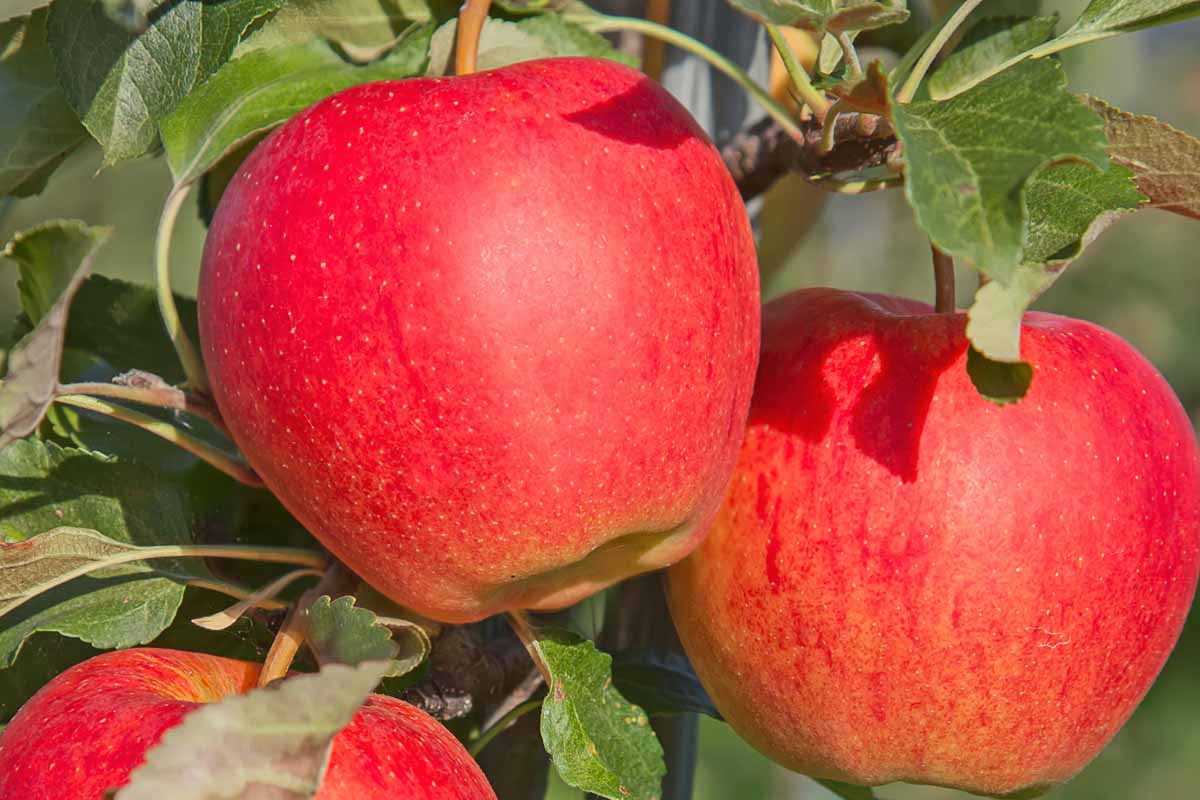
Please leave your comments, questions, suggestions, and requests in the comments – they’re always appreciated!
And for more information on how to grow and care for apple trees, check out some of our other guides:
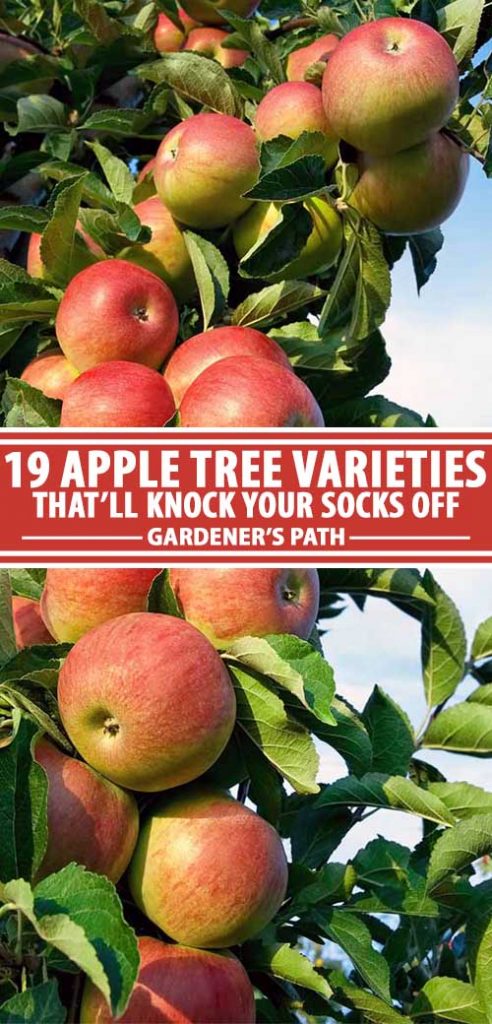
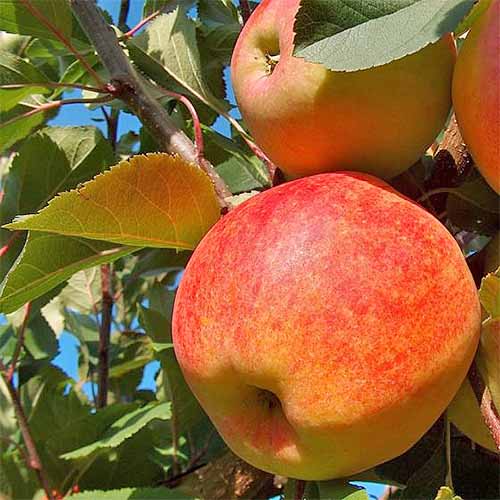
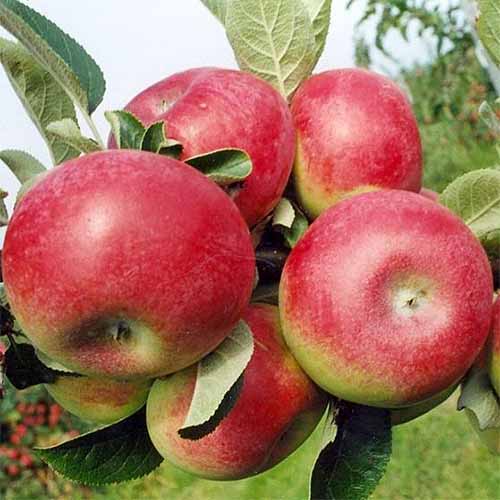
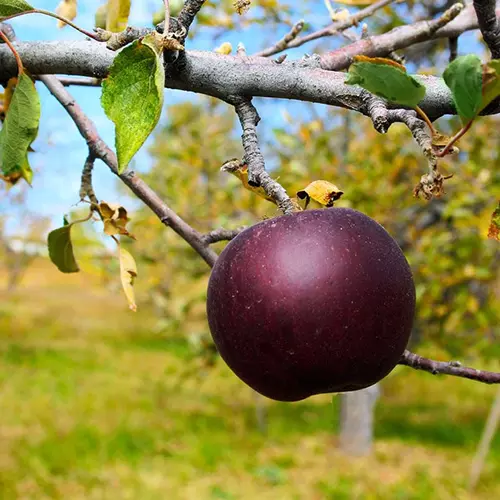

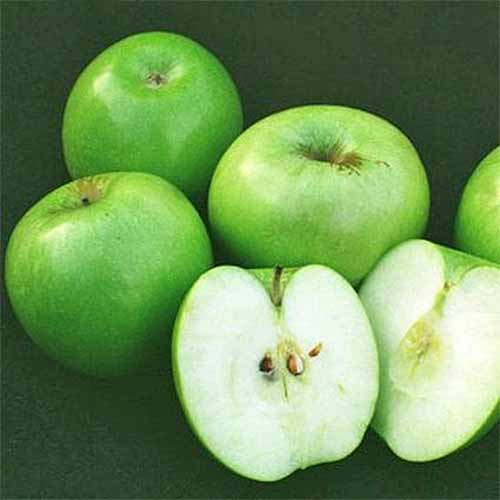
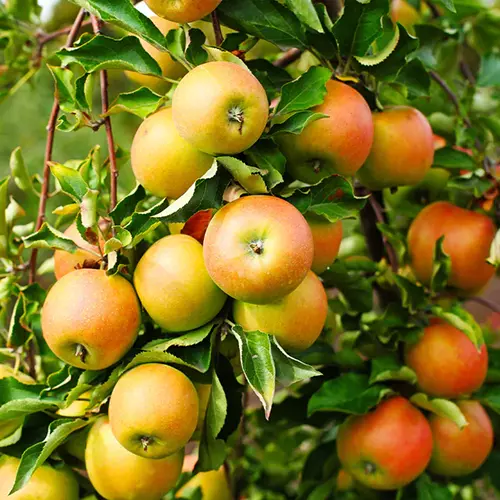
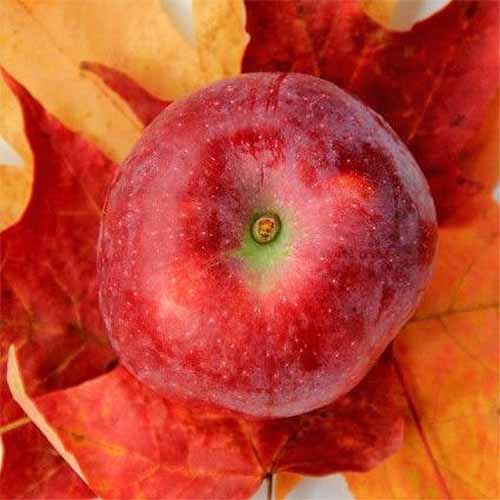
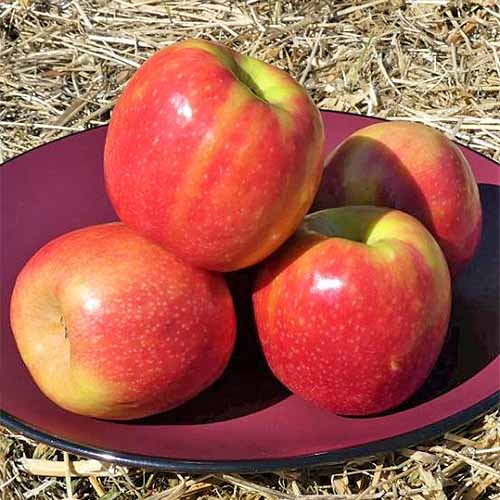
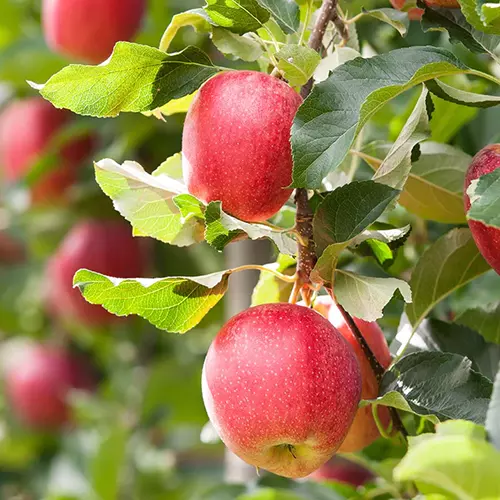


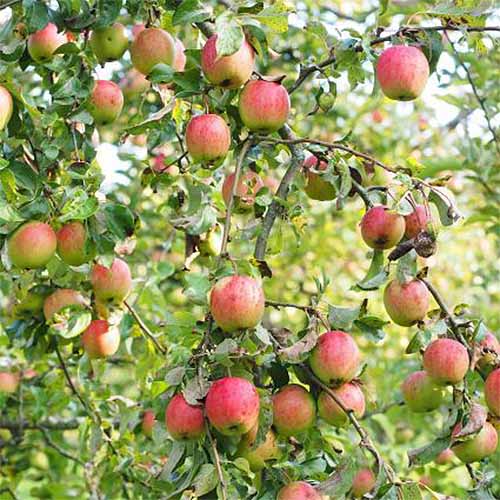
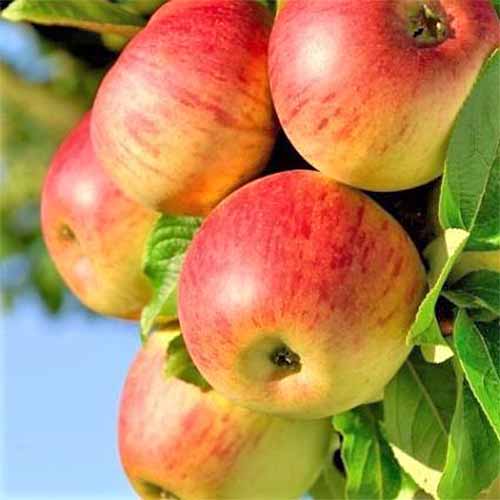
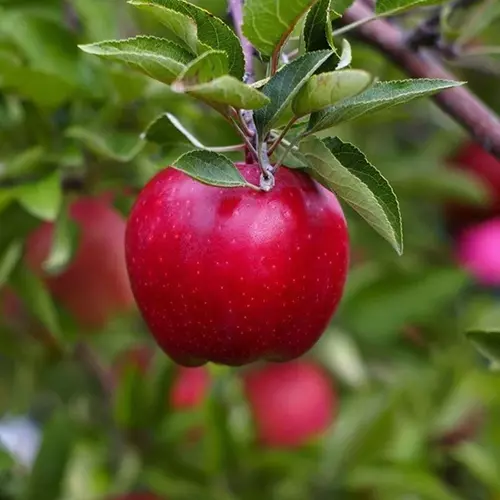
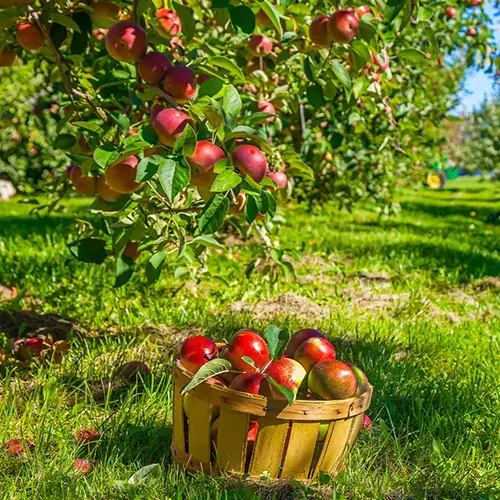
I would like to plant a pink-fleshed apple tree in zone 7. I don’t have a lot of space. Any recommendations?
i want to replace my old apple trees with new variety, please suggest me which type of plants to be planted which may able yield the crop within three to four years. the attitude of my garden is 2500 meters from sea level
Is there more info you could share about the conditions where the tree would be growing? Something like the USDA growing zone or general geographic region? Thanks!
Any idea what this is?
Hi Susanne, thanks for the question and photo. It looks to me like this might be a ‘Wealthy’ apple. ‘Wealthy’ leans toward being a biennial bearer. Have you noticed that it bears a lot of fruit one year and none or hardly any the next?
Below is a photo of a ‘Wealthy’ apple from Wikimedia Commons.
I live in Fresno, CA zone 9b. Generally mild winters but we do get a good amount of chill hours. Many apples go up to zone 7 or 8. If the chill hours are met for a particular tree but it’s not as high as a zone 9 apple tree, does that mean it’s too warm/hot for that tree? We do have hot (dry) summers.